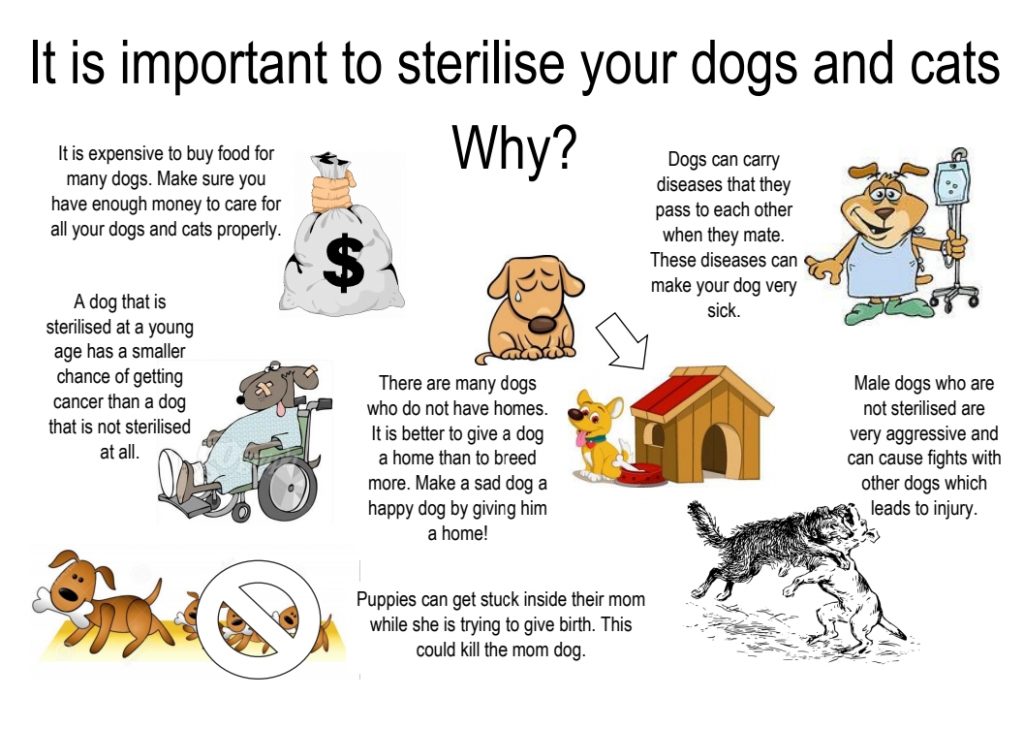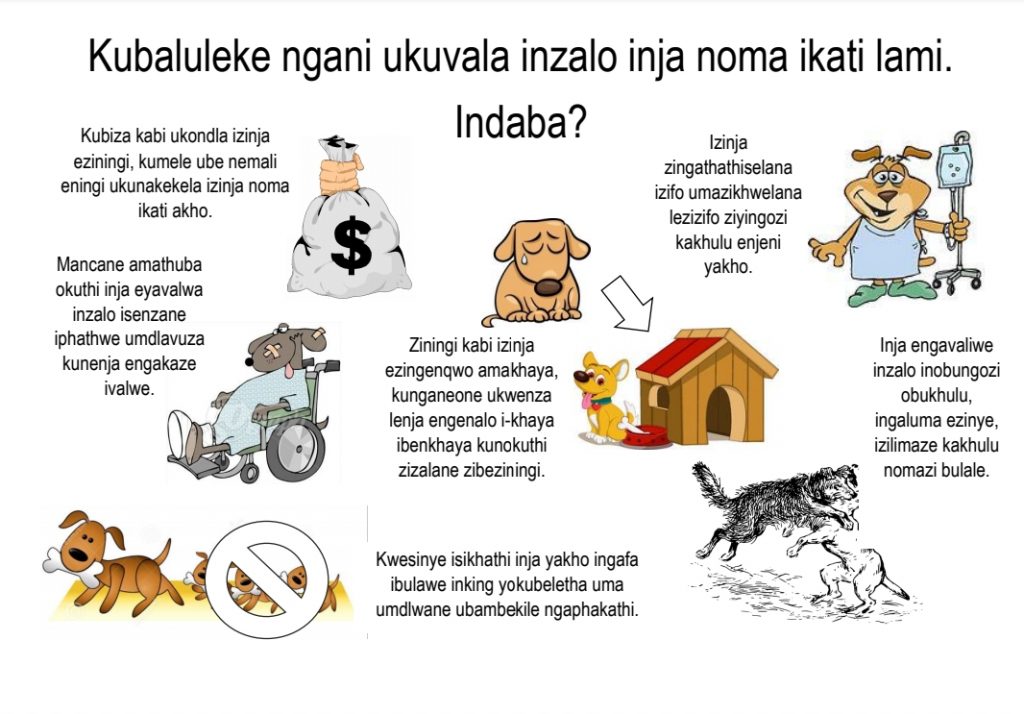
ANIMALS 101 -THE BENEFITS OF STERILISATION INCLUDES NOT JUST CURBING THE UNCONTROLLED BREEDING.
One female cat and her offspring can produce 420,000 cats in seven years. One female dog and her offspring can produce 67,000 dogs in six years. Our biggest struggle in animal welfare is the MASSIVE OVERPOPULATION CRISIS. There are just not enough homes for us to adopt our way out of this mess. Some statistics show that 9 animals will be euthanized for every 1 animal born in the domestic setting.
BENEFITS OF STERILISATION
- Your pet will live a longer, healthier life.
- Spaying and neutering helps prevent certain types of cancers.
- For females it decreases the risk to develop Pyometra which is very dangerous.
- Your spayed female won’t go into heat and cause behaviour changes for her and the males looking for a mate.
- An intact male will do just about anything to find a mate! That includes digging his way under the fence to escape from the yard and once he’s free to roam, he risks injury in traffic and fights with other males or being stolen.
- Intact male dogs and cats may mark their territory by spraying strong-smelling urine all over the house.
- Neutered male cats and dogs fight less, resulting in fewer battle scars, the spread of contagious diseases and abscesses.
- Spaying and neutering your pet is good for the community because stray animals pose a problem for a few reasons including, they can get into fights, cause car accidents, become a nuisance and frighten people.
- There are risks associated with pregnancy and it takes a toll on the mom’s body.
- Having litters or veterinary care related to unsterilised animal health issues (cancers, fights, pyometra) can be expensive.
- Spaying and neutering helps fight the pet overpopulation. Every year, millions of cats, dogs and other animals of all ages and breeds are euthanized or suffer as strays, because there are just not enough homes. Sterilisation takes a few minutes, but the suffering of an abandoned animal, a lifetime.
Also read: ANIMALS 101 – DON’T BE CAPTURED BY CIRCUS CAPTIVITY!


15 MYTHS ABOUT SPAYING & NEUTERING (from Spay & Neuter SA)
Myth #1: If I’m a responsible owner who keeps my animals from wandering around, I don’t need to sterilise my animals.
FACT: People who call themselves ‘responsible owners’ may have good intentions. Accidents happen, all the time! We have countless cases where another unsterilised animal got into that yard and guess what……a litter was born.
Myth #2: Real men need intact male dogs.
FACT: Some guys get squeamish as soon as you suggest that they should neuter their male dog. Dude, lighten up and quit including Fido in your masculine self-image. Pets don’t have any concept of sexual identity or ego.
MYTH #3: My pet will get fat and lazy.
FACT: Pets get fat and lazy because their owners feed them too much and don’t give them enough exercise.
MYTH # 4: It’s better to have one litter first.
FACT: Medical evidence indicates just the opposite. Many veterinarians now sterilise dogs and cats as young as eight weeks of age. Check with your veterinarian about the appropriate time for these procedures and the breed.
MYTH #5: My children should experience the miracle of birth.
FACT: Even if children are able to see a pet give birth – which is unlikely, since it usually occurs at night and in seclusion – the lesson they will really learn is that animals can be created and discarded as it suits adults. Instead, it should be explained to children that the real miracle is life and that preventing the birth of some pets can save the lives of others.
MYTH #6: It was an unexpected litter.
FACT: If your pets are not sterilised, you can totally expect it!
MYTH #7: I want my dog to be protective.
FACT: Spaying or neutering does not affect a dog’s natural instinct to protect the home and family. A dog’s personality is formed more by genetics and environment than by sex hormones.
MYTH #8: My pet is so special, I want puppies or kittens just like her.
FACT: A dog or cat may be a great pet, but that doesn’t mean her offspring will be a carbon copy.
MYTH #9: It’s too expensive to have my pet spayed or neutered.
FACT: The cost of spaying or neutering depends on the sex, size, and age of the pet, your veterinarian’s fees, and a number of other variables. Whatever the actual price, spay or neuter surgery is a one-time cost – a relatively small cost when compared to all the benefits. It’s a bargain compared to the cost of having a litter and ensuring the health of the mother and litter, to treat cancers or injuries from fights.
MYTH #10: I’ll find good homes for all the puppies and kittens.
FACT: You may find homes for all of your pet’s litter, but each home you find means one less home for the dogs and cats in shelters. Also, in less than one year’s time, each of your pet’s offspring may have his or her own litter, adding even more animals to the population. The problem of pet overpopulation is created and perpetuated one litter at a time.
MYTH #11: Preventing pets from having litters is unnatural.
FACT: We have already interfered with nature by domesticating dogs and cats. We domesticated the dog around 15 000 years ago and the cat 8 000 or even more, years ago. In doing so, we helped create this problem. Now it’s our responsibility to solve it. It’s also unnatural to be killing so many of them in our pounds and shelters each year.
MYTH #12: A pet’s behaviour changes dramatically after surgery.
FACT: The only changes in behaviour you’ll see are positive ones with less aggression.
MYTH #13: We don’t need to neuter males, because they aren’t the ones having the litters.
FACT: This is the most prevalent myth yet the most ridiculous. It takes two to tango. A female can have one litter at a time, but the same male can impregnate many females in a short time.
MYTH #14: Dogs and cats should not be spayed until six months of age.
FACT: While this was the recommendation several years ago, it is no longer recommended to wait until a dog or cat is six months of age to spay, with a few exceptions.
MYTH #15: Dogs and cats should be allowed to come into heat before being spayed.
FACT: Spaying a dog or cat after the first heat cycle actually increases the risk of mammary cancers developing later in life. Spaying prior to the first heat cycle is the most current recommendation.

WHY ARE RESCUES SO STRICT WHEN IT COMES TO STERILISATION?
It is counterintuitive to our mission as rescuers to allow puppies, kittens, birds or bunnies to be homed where there are any unsterilised animals. We would not have this massive overpopulation crisis if people sterilised their pets. Be extremely weary of any organisation that is not asking why you have unsterilised pets or who breeds themselves and we have such organisations locally!
Thanks for tuning in! During these festive times, please remember to keep your pets safe, not to give animals as gifts and prepare for fireworks if you have noise-phobic pets.
WHEN YOU KNOW BETTER, DO BETTER!